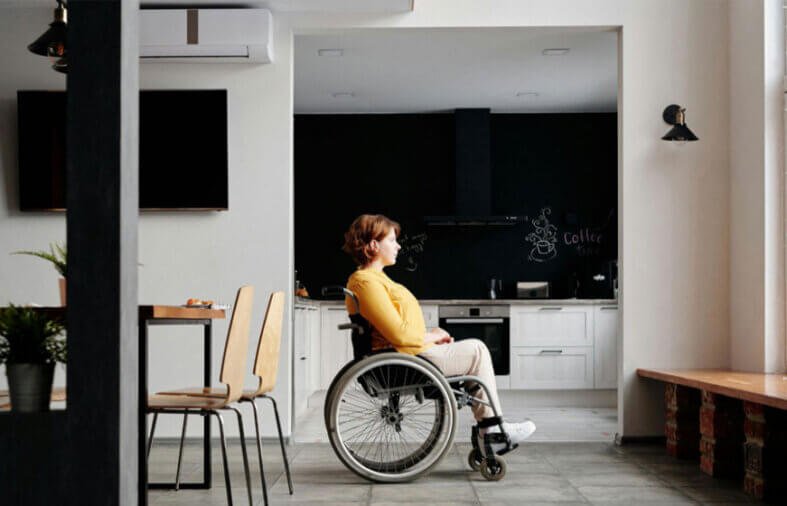Modern technology is helping people with disabilities bridge the gap to a more accessible lifestyle. Today’s smart home technology assists people with mobility or sensory challenges and other needs to more easily perform functions that were difficult in the past.
Home management and functional accessibility are improved with better devices. Technology can help protect health and improve mobility in numerous ways. Innovations, like AI-driven devices, are enhancing independence for people with disabilities and those aging in place.
Smart Technologies to Manage and Maintain Your Home
Using smart technology to manage your home was once a costly indulgence, but as smart homes become more popular, these systems are more available and affordable. Some tech is encapsulated in smart devices, such as the next generation of smart robot cleaners, which can sweep, mop, and vacuum floors. Other robotic devices protect your home and safeguard your pets while you’re out. Robotic lawnmowers are now available to help out with yard work.
In addition to devices, there are also house-wide smart tech systems that can help homeowners with disabilities secure and maintain their homes:
- The ability to manage and monitor your devices and appliances remotely. Control applications through your phone by programming activities that range from dimming your light to turning on your coffee pot.
- Home security systems that connect to your phone and the authorities. View and record suspicious activity triggered by sensors, allowing a measure of safety even when you are not home.
- Smart systems, like thermostats or lighting, let you program functionality to save money on heating, cooling, and electric bills. In addition to making your home more energy-efficient, they provide better accessibility with remote-programming functionality.
The smart homes of the future can help people with disabilities manage health challenges by employing predictive health monitoring. New design innovations, called Fit Homes, are outfitted with strategically placed sensor devices that collect data. This data is then integrated with the homeowner’s health information. It uses analytics to predict potential health issues such as dehydration or missed medications, increasing safety and lowering the need for hospitalizations.
As power grids transition to smarter technologies, they enable enhanced accessibility, benefiting individuals with disabilities by increasing energy resilience and reliability in critical services. Smart grids use real-time data and automation to monitor and manage electricity distribution, reducing outages and minimizing disruptions that can be particularly challenging for people with mobility, sensory, or health-related disabilities.
Innovations in Tech for Health and Mobility
Smart devices also provide unique solutions to improve accessibility and health safety. For example, solar-powered wheelchairs are currently available. No more running out of battery while you’re out on a sunny day; your solar-powered vehicle is ready to go.
Another practical and cost-effective device is the SpO2 sensor, which monitors blood oxygen saturation levels. This informs people whether they are getting enough oxygen in their breath or if they should seek medical attention. It operates by sensing how well light passes through a body part, like your finger, an indicator of how much oxygen your blood contains.
This simple monitoring device can help protect people with epilepsy, respiratory conditions, or sleep apnea, including children. Several types are available but we don’t recommend the less reliable FitBit or smart watch bands for those with a health condition. However, if someone in your home suffers a respiratory issue, you may qualify for funding for one of the more accurate devices.
There are many technological challenges for future inventors to tackle, including opportunities to help the disabled community. Examples include smart eyewear that adjusts to surroundings, such as providing better visibility in the dark or integrating augmented reality into glasses for ease of use. Imagine having your smart home control system projected right onto your lens!
As smart tech grows more intelligent, more assistive tools are being developed to help people with disabilities. One example is the Feathertail Wearable Ergonomic Computer Mouse. Invented by the entrepreneur Zhey Grudov, this air mouse looks and acts more like a watch. The device can be worn on the wrist or attached to a shoe or headset, and employs voice-activated mouse clicks, making it easy for anyone who finds traditional mouse devices inaccessible.
AI-Powered Solutions
New innovations will also be heavily influenced by AI. Right now, AI-based safety systems exist in cars, providing technology that can sense a potential crash and adjust by slowing or braking to avoid disaster. If AI can keep drivers safe, it can also help people with disabilities become more independent.
Examples of technology that use AI to help people with disabilities overcome communication challenges include smart speaker systems, such as Alexa, Google, and Siri, that help people with neurodiverse conditions, such as autism, communicate more easily. Google’s Parrotron helps people with speech challenges express ideas more clearly. Several apps can translate speech into written words or read written text. Plus, tools like ChatGPT can help you write supporting documentation for practical uses, such as applying for benefit programs.
People with reduced dexterity can benefit by using AI to improve accessibility. Google Voice Access, which can act as a virtual assistant, was designed for people with limited dexterity. Another app, IFTTT, connects apps so voice commands can be centralized in one place making it much easier to employ voice-driven tasks, from appliance functionality to reading emails.
AI is also making it easier for people with disabilities to navigate the web. For example, facial recognition can replace CAPTCHAs, which can be difficult for those with visual impairment. Tab buttons can be altered for navigation as well. All this makes logging on and using a website more accessible. Other tools include voice and speech recognition software, audio descriptions of content, captions, translations, and graphic element adjustments. There is even a library of uncommon idioms and slang available for people with intellectual disabilities.
Today’s advances in technology, from smart-home innovations to the deployment of AI, can help people with disabilities.








